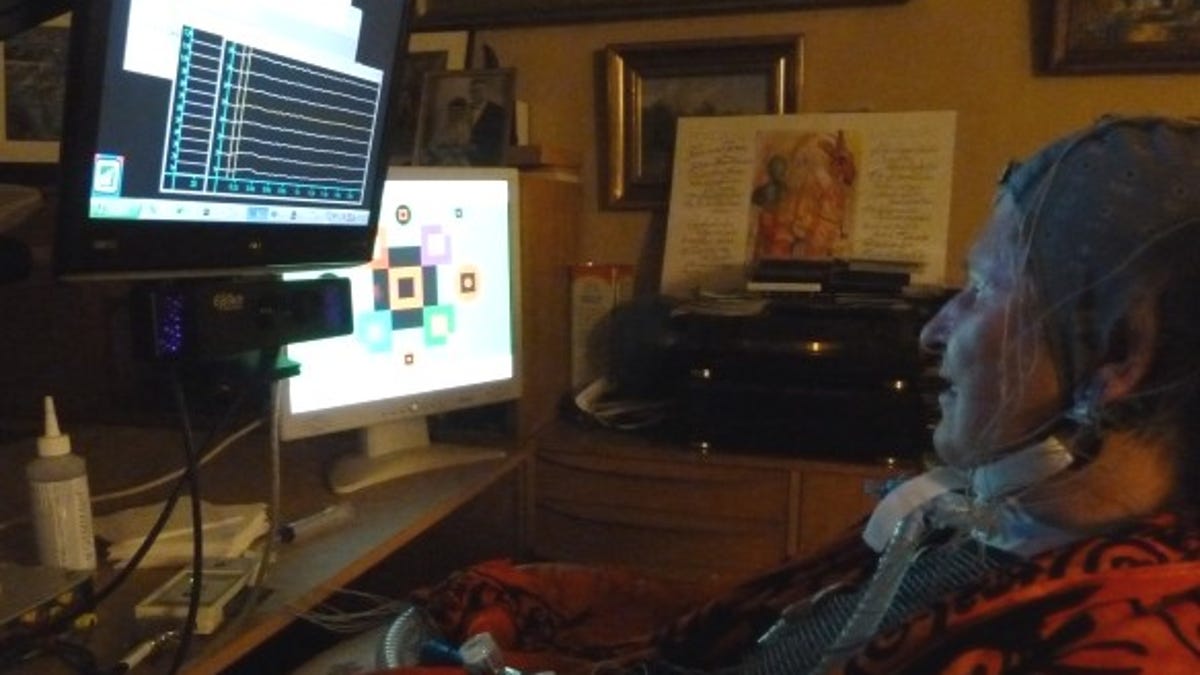Paralyzed artist paints with mind alone
A woman with Lou Gehrig's disease paints using software that lets her control digital brushes with brainwaves. Now, thanks to a crowdfunding push, she's realizing her dream to exhibit her work.

Heide Pfüetzner calls her 2007 diagnosis with Amyotrophic Lateral Sclerosis, or Lou Gehrig's disease, a "personal catastrophe." Six years later, she's celebrating a personal triumph as an exhibit of her paintings, all created by her mind controlling a computer, makes its debut.
The exhibit, titled "Brain on Fire," opened Friday on Easdale, a small island off the west coast of Scotland. Visitors to the Easdale Island Hall there will see vibrantly colored digital paintings created by the paralyzed artist using a computer program that lets her control digital brushes, shapes, and colors by concentrating on specific points on the screen.
"For the first time, this project gives me the opportunity to show the world that the ALS has not been the end of my life," Pfüetzner says on the Startnext crowdfunding page where she exceeded her $6,500 goal for mounting an exhibit in Easdale. Pfüetzner's daughter lives on the island; the longtime painter visited often before her illness and considers it one of her favorite destinations.
Pfüetzner, a former English teacher from Leipzig, Germany, "brain paints" using software developed by the University of Wurzburg and German artist Adi Hösle, along with equipment from biomedical engineering firm Gtec. Settled in her wheelchair in front of two monitors, she wears an electrode-laden electroencephalogram (EEG) cap.
One screen displays the program's matrix of tools, the other functions like a canvas, showing the picture as it evolves.
Images of the various tools flash at different times. Pfüetzner focuses on the tool she wants to select, causing her brain activity to spike. The computer determines which option she's focusing on by comparing the timing of the brainwaves to the timing of the desired flashing tool.
Prior to becoming ill, "I had never been fond of technical equipment, and despised working with a computer," admits Pfüetzner, who can communicate only using her eyes and who breathes with the aid of a ventilation machine. But an EEG cap and brain computer interface have become her everyday companions.
"BCI is a pioneer-making technology which allows me to create art and therefore, reconnect to my old life," she says.
Similar computer systems have helped others with disabilities, allowing a man with locked-in syndrome to tweet through eye movements, for example, and a quadriplegic woman to control a robotic arm to manipulate objects. The brain-computer-interface team at the University of Wurzburg has studied extensively the mechanics and significance of pushing BCI applications for the paralyzed beyond text input into the realm of visual art (read about their research in this Frontiers of Neuroprosthetics article).
ALS is a debilitating progressive neurodegenerative disease characterized by widespread muscle atrophy that affects mobility, speaking, swallowing, and breathing. Though the life expectancy of an ALS patient averages about two to five years from the time of diagnosis, according to the ALS Association, some ALS patients, including physicist and cosmologist Stephen Hawking, have far outlived that prognosis.
Money raised through Pfüetzner's Startnext campaign went toward printing and framing her work, as well as transporting her and her nursing team, as well as the medical equipment she needs, to Easdale, where the exhibit runs through July 25.
Clarification, July 23 at 5:35 p.m. PT: The story has been updated to indicate that the University of Wurzburg and artist Adi Hösle created the software used by Pfüetzner, with Gtec providing hardware.

